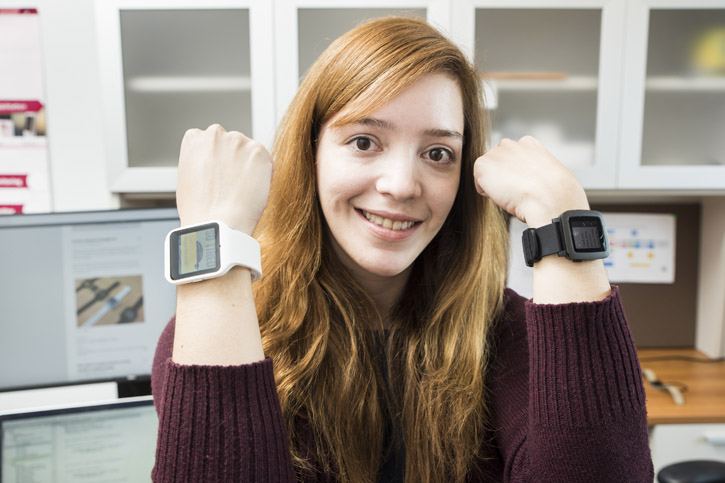
Vivian Motti, Assistant Professor, Information Sciences and Technology, and her team of investigators designed and developed Amulet, an electronic bracelet and software framework that enables developers to create user-friendly mobile health applications. Photo by Ron Aira.
A researcher at George Mason University has joined with teams from Dartmouth College and Clemson University to develop a more technologically advanced, wearable mobile health device.
Vivian Motti, a professor in the Department of Information Sciences and Technology at the Volgenau School of Engineering, came to George Mason from Clemson in January 2016, and brought with her this cutting-edge project that works along the same lines as popular wearable fitness trackers. Her team has been awarded a two-year grant of $43,677 from the National Science Foundation to create computational jewelry for mobile health with a device they’ve dubbed the Amulet bracelet.
Amulet lets users manage their health and wellness by interacting with other wearable health sensors, constituting what Motti calls a user’s “wireless body-area network.” The Amulet device serves as a “hub,” tracking health information and securely sending data to other health devices or to medical professionals.
Potential applications for the Amulet also include tracking the use of medications, sending reminders when doses are due, and providing critical health data to responders in a medical emergency. At the same time, it protects users’ privacy by enabling them to control what is sensed and stored, where it’s stored and how it’s shared.
Building the Amulet prototype from scratch proved tougher than expected, Motti admits. Issues such as telecommunication, networks, the application itself, ergonomics, battery life, and software all had to be resolved inside a device that users would actually want to wear.
“It’s hard to prioritize what to put into the design while still making it comfortable for the user and able to perform the tasks effectively,” Motti says. “That was the most challenging part.”
Motti and her team at the Human-Centric Design Lab focus on making sure the device is both useful and easy to use.
Early prototypes were large and heavy, but the team managed to reduce the size of components until they had a thin, lightweight device that sends signals to users through vibrations, and features a graphic interface and carefully positioned buttons. And since it’s worn around-the-clock, they’re making it water resistant, too.
Three prototypes have been created so far, each with a different focus. The first was crafted to aid in smoking cessation. From there, a stress management bracelet was fashioned to monitor anxiety levels. The third is centered on weight loss and includes an activity meter.
Motti’s team expects to have a commercial product available within two years. So far, she said, feedback has been positive, and suggestions are still being used to improve the prototypes.
“We’ve had some specific remarks on the interaction,” she said, “for instance, when the buttons were too small or their placement wasn’t comfortable. So we considered rotating the display or changing the design.”
Having focused on wrist-worn interaction and wearables while completing her postdoctoral work at Clemson, Motti said her interest in the devices stems from a desire to connect technology with people on a personal level.
“I see it as a tool to empower users with information,” she said. “Wearables can really bring technology closer to the user’s life in a nonintrusive, accessible way.”
